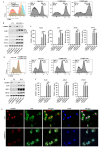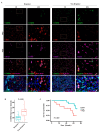Unveiling the mechanisms of CEBPD-orchestrated TAM polarization through RGS2/PAR2 pathway and its impact on ICB efficacy in clear cell renal cell carcinoma
- PMID: 40659446
- PMCID: PMC12258302
- DOI: 10.1136/jitc-2024-010898
Unveiling the mechanisms of CEBPD-orchestrated TAM polarization through RGS2/PAR2 pathway and its impact on ICB efficacy in clear cell renal cell carcinoma
Abstract
Background: The polarization status and function of tumor-associated macrophages (TAMs) influence tumor progression and patients' prognosis. CCAAT/enhancer-binding proteins (CEBPs) family are important transcriptional factors in macrophages differentiation physically and pathologically. This study aims to explore the mechanism of CEBPs in TAMs polarization in clear cell renal cell carcinoma (ccRCC) immune microenvironment and its impact on immune checkpoint blockers (ICBs) therapy.
Methods: The expression of CEBPs in ccRCC was analyzed by single-cell transcriptome and western blot. Immunofluorescence and in-vitro polarization assay were used to evaluate the effect of CEBP delta (CEBPD) on TAMs. Chromatin immunoprecipitation sequencing was used to explore targets of CEBPD. Dual-luciferase reporter assay and electrophoretic mobility shift assay were performed to confirm the regulation of CEBPD to RGS2. Specimens of patients received ICB therapy were used to analyze the relationship between CEBPD and immunotherapy.
Results: The study identified CEBPD as a key transcriptional factor in ccRCC TAM polarization. Upregulation of CEBPD correlates to decreased M1/M2 ratio of TAMs and poorer clinical outcomes. CEBPD inhibited M1-like polarization in vitro and in vivo via the RGS2/PAR2 axis. Furthermore, CEBPD also affected the therapeutic efficacy of ICB.
Conclusion: This study revealed CEBPD regulated TAM polarization via the CEBPD/RGS2/PAR2 axis. Targeting CEBPD may be a potential approach and a complementary strategy to ICB therapies in ccRCC.
Keywords: Immunotherapy; Kidney Cancer; Macrophage.
© Author(s) (or their employer(s)) 2025. Re-use permitted under CC BY-NC. No commercial re-use. See rights and permissions. Published by BMJ Group.
Conflict of interest statement
Competing interests: None declared.
Figures








References
MeSH terms
Substances
LinkOut - more resources
Full Text Sources
Medical
